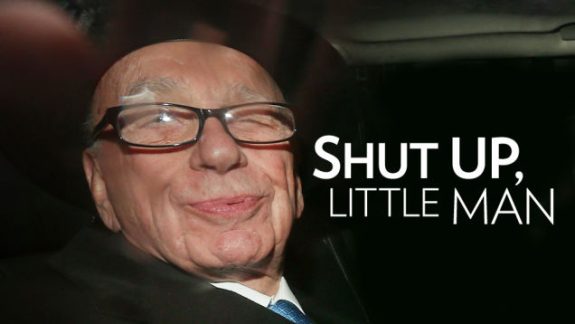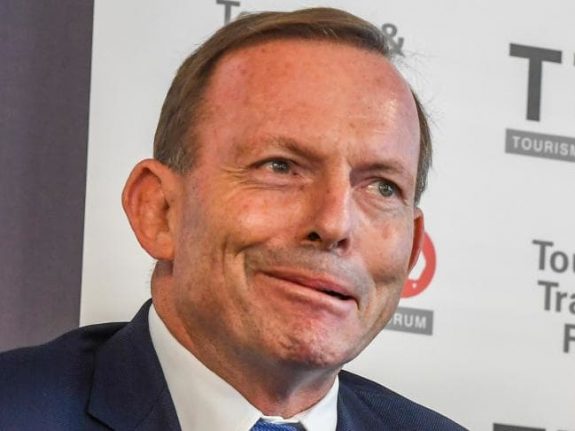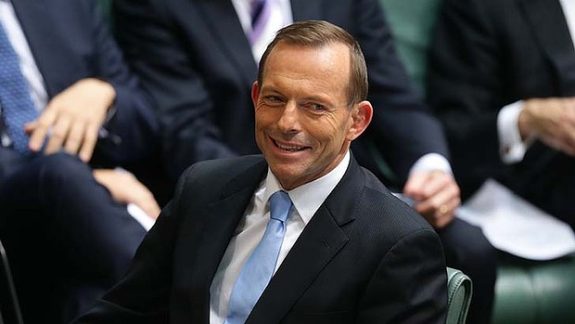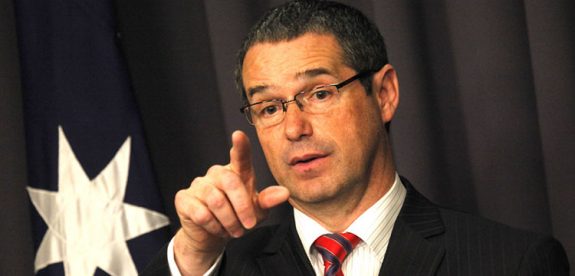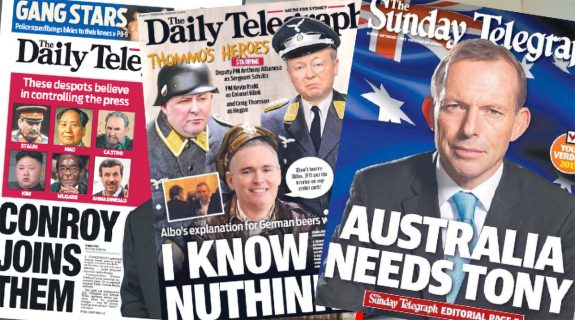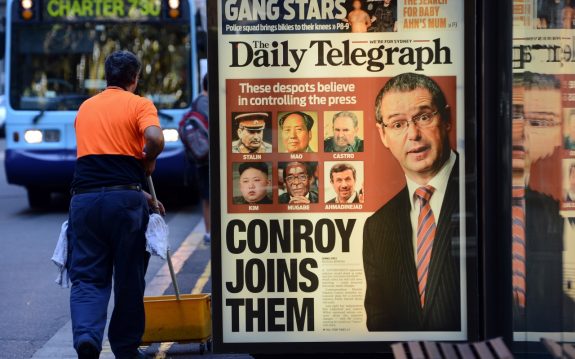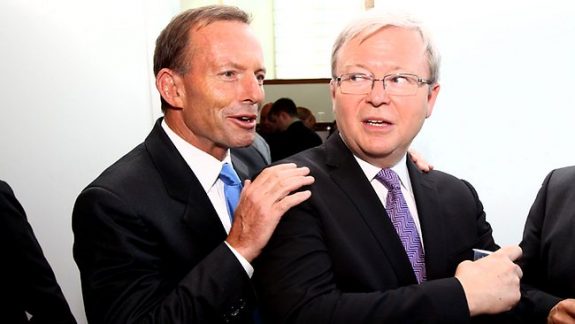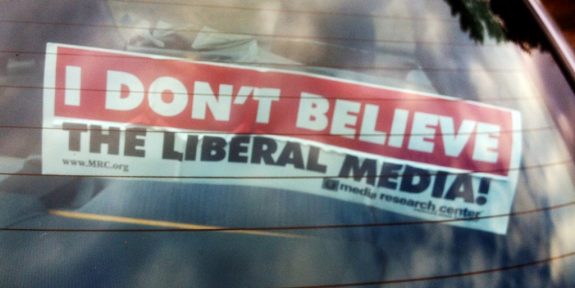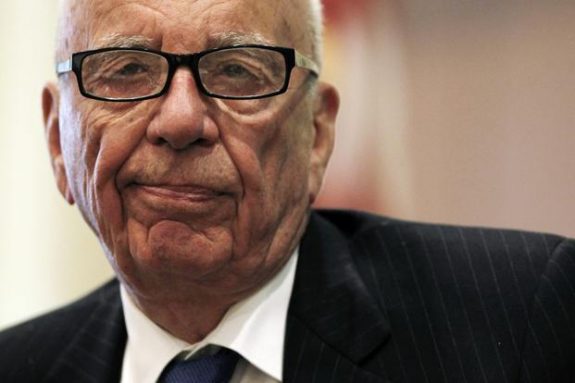Overnight, elements of the mainstream media (MSM) displayed the gutter journalism and sensationalist crap that Senator Conroy admirably wants to tackle head on in this country. He rattled a few cages and the MSM are squealing like stuck pigs. They are behaving like pigs too. The front page of The Daily Telegraph (above) deserves nothing better than to line the kitty litter tray (as should the whole paper, if you’re brave enough to buy it). I cannot find enough words to describe my utter disgust at this piece of filth. It is so wrong.
Senator Conroy, to his credit, shrugged it off. I don’t think too many other decent people will.
He has certainly hit a raw nerve and the more restrained responses have that guilty look about them. Take these sentences in today’s editorial in The Australian:
The minister has never hidden his dissatisfaction with News Limited, publisher of The Australian, or his warm relationship with other media proprietors. Indeed, free-to-air television networks are the winners.
The removal of the “75 per cent rule” will allow the Nine Network to buy its affiliate, Southern Cross, thus reducing diversity. At the same time, regulations governing free-to-air television remain the same.
To me, this sounds like The Australian has voluntarily put its hand up as the nasty guy while stressing they need to be the major player in Australian print media. To continue on unabated.
Even the Sydney Morning Herald, on their web site were playing the same fiddle:
The chief executives of Australia’s biggest print and online news media, including Fairfax Media, publisher of this website, have come out against the reforms announced by Mr Conroy on Tuesday, saying they were unclear and would introduce uncertainty into the media landscape.
Yes, let’s keep the certainty. Let’s keep having a media that publishes front pages that compare an elected politician to mass murderers. Pathetic.
But now to the crux of my post. Up until 2007 the media barons controlled the Government. Losing this control is more the issue here. Let’s take a look at a few significant moments from the Howard years, thanks to the Centre for Policy Development:
Pre-1996 election
Opposition Leader John Howard is rumoured to have reached an understanding with Kerry Packer to remove the cross-media ownership restrictions that mean he is prevented from buying Fairfax. Packer appears on his Nine Network to endorse John Howard for Prime Minister. The Coalition promises a full public review of cross-media rules.
1996
October
Communications Minister Richard Alston scraps the promised review and instead calls for private submissions to be sent directly to the Department of Communications, Information Technology and the Arts (DCITA) for analysis by Alston’s advisors.
1997
April
Howard says he believes the cross-media rules should be scrapped, but favours retaining limits on foreign ownership.
The Coalition backbench says it is worried about media ownership and wants a role in formulating policy.
Howard meets with Murdoch and Packer. Network Seven owner Kerry Stokes accuses Howard of doing a deal with Packer over Fairfax.
May
Howard says he won’t consider relaxing foreign ownership limits, claiming that “70-80 per cent of the newspapers of this country are owned by foreign interests”.
Liberal MP Gary Hardgraves, deputy chair of the Coalition backbench communications committee, writes to Howard: “I have been contacted by several colleagues requesting no public announcement of any changes in cross-media ownership provisions be made until the committee has been afforded a full briefing with opportunity to comment. As a committee we are very concerned matters will be decided before we are consulted.” (The Age, 6/5/97)
James Packer appears on the Nine Network and announces that he wants Fairfax for Christmas.
The Coalition backbench tells Howard it will not back change without partial relaxation of foreign ownership limits to keep the industry competitive. Hardgrave explains that “There was no one here who could take on Packer, so it had to be a foreigner. We went for diversity over xenophobia.”
Howard again refuses to consider abolishing limits on foreign media ownership but, under pressure from his backbench, offers Murdoch a lift in foreign ownership limits from 15 percent to 25 percent.
Cabinet considers Richard Alston’s plan and advises him to consult the backbench.
June
James Packer lobbies backbenchers for relaxation of cross-media ownership restrictions.
ABC Television hosts a debate on media policy. No one from the Murdoch or Packer companies participates.
August
Murdoch says no to Howard’s offer, and threatens to fight any attempt to give Fairfax to Packer without the abolition of foreign ownership restrictions at the same time.
Howard dumps the plan.
September
Howard tells Cabinet he’s dropped the issue after the backbench committee announces “MPs would not accept any policy that allowed the Packers or Rupert Murdoch to own more of the Australian media”.
Alston tells Parliament that Cabinet bailed out “because they well understood that the Australian public was interested in the real issues”.
2001
Pre-election, 2001
The Government announces it will review media ownership laws after the election.
Howard meets Rupert Murdoch in the United States just before the September 11 attacks. Insiders assume a deal was done whereby the Murdoch press would support Howard in the election campaign, and in return Howard would alter legislation to allow Murdoch to expand his media interests in Australia by buying a television network.
2002
January
Richard Alston meets Rupert Murdoch in New York to discuss possible changes to media ownership laws.
Alston dumps his promise of a review, and instead holds private talks with media players, obtaining majority agreement for his plan.
March
Cabinet approves the Alston-Howard plan to abolish cross-media and foreign ownership restrictions on the media, which would allow Packer to buy Fairfax and Murdoch to buy a television network.
March 19
Alston presents proposed legislation to the Coalition party-room meeting as a done deal.
At least ten backbenchers protest, saying Alston hasn’t explained what the legislation means and demanding more time to consider it. Critics include National Party MPs Paul Neville, De-Anne Kelly and Ron Boswell, Victorian Liberal MPs Bruce Billson, Petro Georgiou and Sophie Panopoulos and NSW Liberals Bruce Baird, Bronwyn Bishop and Marise Payne.
The Sydney Morning Herald reports: “They are concerned at the impact such a liberal regime would have on media diversity in the bush and the centralising of ownership that would result from a relaxation of the cross-media laws. A few backbenchers
fear that in the absence of a strong cross-media regime foreign investors could buy up as many local media outlets as they liked.”
Major media players arrive in Canberra to begin lobbying politicians to support the Alston plan. Critics claim that this is proof that they all knew the detail of the plan before the Coalition’s own backbench.
March 20
A hastily formed new communications backbench committee agrees to the original plans after meeting with Alston. No committee members will reveal the reasons behind their about-face.
March 21
The coalition party room approves the Alston-Howard plan and Alston introduces it into the House of Representatives.
June
A Senate Committee inquiry rejects the Alston plan, but Western Australian Liberal Senator Alan Eggleston, Tasmanian Liberal Senator Paul Calvert and Victorian Liberal Senator Tsebin Tchen back it with two provisos:
1. Any company could own only two of the three media – TV, radio and newspapers – in any one region;
2. A media group should be required to disclose its ownership of another media group when it is reporting on the latter.
(http://www.aph.gov.au/Senate/committee/ecita_ctte/media_ownership/report/report.pdf)
September
Alston agrees to these changes and starts negotiating with the four independent / minor party Senators whose support he needs to pass the bill: South Australian ex-Democrat Meg Lees, Tasmanian ex-Labor Senator Shayne Murphy, Queensland One Nation Senator Len Harris and Tasmanian independent Senator Brian Harradine.
2003
June 22
Alston announces a new offer to the independents, including cash to extend the reach of ABC news radio to the regions.
June 25
The Senate passes Alston’s bill with Brian Harradine’s amendment, which bans a company owning a newspaper and a television station in the same capital city market.
June 26
The House of Representatives rejects the Senate compromise and re-passes Alston’s legislation.
June 27
The House of Representatives lays the bill aside.
Alston announces he’ll demand the Senate pass his original legislation in October, and ensures that all the preconditions are met to make the bill part of a double dissolution election trigger.
July
Alston starts negotiations with the Democrats to pass the legislation.
November 5
The Bill is reintroduced into the House of Representatives.
December 1
The house passes the Bill, in the same form as that introduced on 15 October 2002, with the addition of amendments passed by the Senate and agreed to by the House.
December 2
The Bill is reintroduced into the Senate; the second reading debate adjourned.
2004
The Bill lapses following the calling of the 2004 Federal election.
The Howard Government includes a commitment to reform media ownership laws in its election platform.
2005
The Government commences consultations with stakeholders on possible approaches to media ownership reform.
2006
14 March 2006
After months of unexplained delays, Communications Minister Senator Helen Coonan releases a discussion paper on media reform, entitled Meeting the digital challenge: reforming Australia’s media in the digital age. The paper is open for public discussion and submissions for one month, until the 18th of April.
I don’t know about you, but I think some of that is rather damning. Howard consulting Murdoch on proposed media changes. Obviously Senator Conroy was unaware that Rupert had to be consulted first. In 1997 George Megalogenis caught a whiff of Howard’s backroom deals. George wrote:
Howard himself fed this perception by telling colleagues he thought the Fairfax papers lacked direction. Howard believed the Sydney Morning Herald, for example, was not fulfilling its potential of becoming a quality” small-c conservative” broadsheet like The Times in London.
Early on in the process, Howard and Communications Minister Richard Alston decided the way to counter the inevitable claims of bias towards Packer was to give Rupert Murdoch’s News Limited, which publishes The Weekend Australian, a share of the media spoils.
The economics, as well as the politics, of the issue demanded that the cross-media rules preventing someone could not be reformed in isolation.
The foreign ownership rules, which restricted News from expanding further in Australia, also had to be looked at. But unlike Keating, Howard could not strike a balance that placated both Packer and Murdoch.
Every model that Howard and Alston came up with gave Packer an easier run at taking over Fairfax than it gave Murdoch at controlling Seven. Insiders now agree that Howard effectively killed his own reform drive on April 30 when he went on Melbourne radio station 3AW to talk up the Packer cause. The Prime Minister said then there were three choices on media policy – do nothing; open up the media to all comers; or reform the cross media rules while retaining the existing controls on foreigners. (Interestingly, Howard did not mention option four which he had discussed with Murdoch – relaxing both cross-media and foreign ownership controls).
It certainly continues to be damning, not just for the Howard Government (and I suspect the current Opposition) but also for Murdoch. That’s Conroy’s problem: he won’t hop into bed with Murdoch so he’s rallied his troops. This too, is so wrong. Media Content is Influenced by Ownership, and that suited both the Howard and Murdoch to a tee:
Media companies are not solely a means to earn income. They are frequently also a vehicle for furthering the interests of their owners. Expression of an owner’s political interests is rarely as overt as it was in 1995 when Kerry Packer appeared on his own Nine Network and declared that John Howard, then leader of the Liberal National Party Opposition, would make a good Prime Minister. It usually occurs in subtle ways, through the
appointment of senior management and, in turn, the selection of stories and the way in which information is presented to the public.
The public is frequently unaware of information that should but does not come to its attention. For example, back when Nine promoted itself as the major television news network and was owned by the Packer family, which also had strong financial interests in casinos, it was highly unlikely that Nine would have screened weighty content on serious social problems that have resulted from the proliferation and promotion of legal gambling.
The editorial position of News Corporation’s newspapers around the world in support of the 2003 US led invasion of Iraq is one example of homogeneity of perspective on a crucial matter of public interest.Undertakings given by media companies bidding for AFL rights to support and promote the sport rather than ‘bag’ or ‘demonise’ it provide another one.
In his recently published book, ‘Rupert Murdoch: An investigation of political power’, David McKnight (Associate Professor and a Senior Research Fellow at the Journalism and Media Research Centre at the University of NSW) has described Rupert Murdoch’s use of his media empire to further his political agenda over decades.
There has been widespread speculation by media and business analysts and commentators that shareholdings which Gina Rinehart (mining magnate and Australia’s richest person) has recently acquired in the Ten Network last year, and recently in Fairfax are in pursuit of influence for her mining interests, not investment potential.
Murdoch has a Howard ‘mimi-me’ in Abbott, whereas Conroy won’t bend over.
That is so good.
Like what we do at The AIMN?
You’ll like it even more knowing that your donation will help us to keep up the good fight.
Chuck in a few bucks and see just how far it goes!
Your contribution to help with the running costs of this site will be gratefully accepted.
You can donate through PayPal or credit card via the button below, or donate via bank transfer: BSB: 062500; A/c no: 10495969












